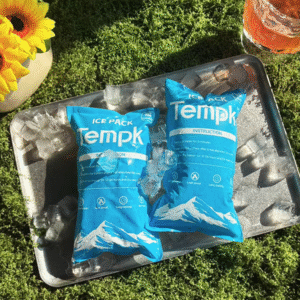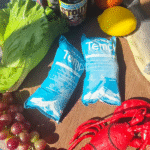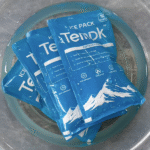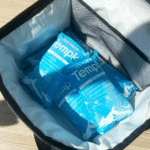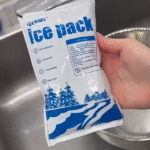Portable Dry Ice Packs: Wie Sie wählen 2025
If you ship or travel with frozen goods, portable dry ice packs are your simplest path to reliable sub‑zero control for 24–96 hours. You’ll learn how to size packs, meet safety rules, and lower total cost. You’ll also see 2025 trends that make portable dry ice packs smarter, leichter, und einfacher zu prüfen, so you can prevent temperature excursions and protect margin.
-
What defines high‑performance portable dry ice packs for lanes and seasons?
-
How do you size portable dry ice packs for 24–96 hours without waste?
-
Which safety labels, venting practices, and SOPs apply to portable dry ice packs?
-
How portable dry ice packs cut claims and courier surcharges across routes
-
How to validate portable dry ice packs before scaling to all sites
What makes portable dry ice packs “portable” and reliable in 2025?
Portable means consistent cold in a compact format that fits varied coolers and shippers without re‑engineering your process. Reliable means predictable hold time, strong wrap integrity, documented CO₂ purity, and proven performance in your lanes. Modern portable dry ice packs combine dense pellets or blocks with vapor‑permeable sleeves that vent safely while resisting tears and dust.
In der Praxis, portable dry ice packs should arrive ready to drop into coolers, meal‑kit totes, clinical shippers, or field cases. Look for clear net mass per pack, Und 1845 guidance, and lot traceability. Blocks hold longer; pellets fill voids for faster pull‑down. Hybrid sleeves blend both behaviors. Choose formats that match payload geometry and handling at your busiest site, not your most careful site.
Pellets vs. Blöcke vs. sleeves: which portable dry ice packs fit best?
Pellets flow around awkward shapes and speed pull‑down, which helps when products start warmer than ideal. Blöcke sublimate slower, so they extend hold time during delays. Hybrid sleeves combine a pellet core with semi‑rigid walls for fewer losses during rough handling. For many teams, portable dry ice packs in sleeve format reduce housekeeping and keep labels readable.
| Format Comparison | Beste Verwendung | Uhren | Was es für Sie bedeutet |
|---|---|---|---|
| Pellets (3–16 mm) | Lückenfüllung, quick pull‑down | Slightly faster loss | Great around trays and odd shapes |
| Blöcke (2–10 lb) | Long lanes and delays | Less flexible fit | Fewer re‑icing events |
| Hybrid sleeves | Mixed payloads, busy ops | Higher unit price | Balanced cold + clean handling |
Practical tips and advice
-
For home diagnostics: Use hybrid sleeves as portable dry ice packs to simplify training and reduce dust.
-
For seafood: Place a block layer under the load, then top with a thin pellet sleeve to remove warm pockets.
-
For desserts: Pre‑chill payloads; then use smaller portable dry ice packs to trim courier surcharges.
Wirklicher Fall: A Midwest lab switched from loose pellets to two hybrid portable dry ice packs per shipper. Hold time rose by a full delivery day while average dry ice mass fell 12%, cutting re‑icing and claims.
How do you size portable dry ice packs for 24–96 hours?
Start with lane hours, shipper insulation, Nutzlastmasse, and starting temperature. Then translate total heat gain into dry ice mass, and convert mass into the count of portable dry ice packs. Oversizing increases cost and CO₂ exposure; undersizing drives excursions. A repeatable estimator helps new packers get it right the first time.
Portable dry ice packs shine when you plan for the route you actually run. Add a delay buffer for peak season. If payloads start near ambient, include a pull‑down adder. When your shipper insulation improves, reduce pack count rather than leaving “free cold” to evaporate into thin air.
A lane‑based estimator for portable dry ice packs
Planning ranges you can adapt
| Target Hold Time | Basic Shipper | Premium Shipper | Ultra Shipper | Was es bedeutet |
|---|---|---|---|---|
| 24 Std. | 3–4 lb (1–2 portable dry ice packs) | 2–3 lb (1–2 packs) | 2 lb (1 Pack) | Premium/Ultra lower mass |
| 48 Std. | 6–8 lb (3–4 packs) | 5–6 lb (2–3 packs) | 4–5 Pfund (2–3 packs) | Hinzufügen 10% Im Sommer |
| 72 Std. | 10–12 lb (5–6 packs) | 8–10 lb (4–5 packs) | 7–8 lb (3–4 packs) | Combine blocks + Pellets |
| 96 Std. | 14–18 lb (7–9 packs) | 12–15 lb (6–7 packs) | 10–13 lb (5–6 packs) | Validate with loggers |
Umsetzbare Zeiger
-
Pre‑condition payloads and shippers; portable dry ice packs last longer in cool containers.
-
Tighten voids with foam corners or trays to stop packs from sliding and tearing.
-
Replace one pellet pack with a small block for routes prone to delays.
Pilot outcome: A specialty dessert brand re‑mapped its lanes and replaced four small portable dry ice packs with three mid‑size blocks. Summer claims dropped 40% and shipping weight fell 1.5 lb per box.
What safety rules govern portable dry ice packs?
Dry ice is UN 1845, eine Klasse 9 gefährlich gut; Etiketten, Netzmasse, and venting are required in many scenarios. Portable dry ice packs should include guidance on ventilation paths and safe disposal. Train staff on PPE and CO₂ exposure risk, especially in small rooms or vehicles. Never place portable dry ice packs in sealed containers.
Air shipments require carrier‑specific limits and paperwork. Ground shipments still need ventilation and clear instructions for drivers and receivers. Keep SDS on file and refresh training annually or when SOPs change. Strong sleeves and legible labels reduce housekeeping and audit friction.
Etiketten, Entlüftung, and training for portable dry ice packs
-
Markieren Sie Pakete mit Und 1845 and net mass of dry ice when required.
-
Use packaging with built‑in vent paths; never fully airtight.
-
Bieten PS: cryogenic gloves and eye protection; Vermeiden Sie den Kontakt mit nackten Hand.
-
Stage portable dry ice packs in belüftet areas and rotate FIFO.
| Erfordernis | Luft | Boden | Warum ist es wichtig |
|---|---|---|---|
| Und 1845 + Netzmasse | Stets | Oft | Helps responders and audits |
| Entlüftung | Stets | Stets | Verhindert den Druckaufbau |
| Driver instructions | Per carrier | Ja | Safer delivery and fewer claims |
| SDS & Ausbildung | Ja | Ja | E‑E‑A‑T, worker safety, Einhaltung |
Praxisbeispiel: A coastal seafood shipper added net‑mass labels and orientation arrows to cases with portable dry ice packs. Inspection time at hubs fell by minutes per pallet, and late‑night holds disappeared.
When should you blend portable dry ice packs with gel packs or PCM?
Blend when your product tolerates higher setpoints or when seasons swing. Portable dry ice packs keep products frozen; Phase -Klopfen -Materialien (PCMs) or gel packs stabilize chilled ranges. During shoulder seasons, combining a small dry ice sleeve with a PCM panel can cut total CO₂ while keeping a safe margin.
Hybrid packouts using portable dry ice packs
-
Keep fragile products off direct contact by adding a corrugate tray above portable dry ice packs.
-
Use a thin PCM layer on top for shock absorption and temperature smoothing.
-
Validate both components together; mixed packouts behave differently from single‑media setups.
| Hybrid Option | Gefrorene Waren | Gekühlte Waren | What you gain |
|---|---|---|---|
| Dry ice blocks + PCM lid | Exzellent | Not needed | Long hold + top protection |
| Pellet sleeve + Gelpackungen | Too warm | Gut | Shoulder‑season savings |
| Block base + pellet topper | Exzellent | Not applicable | Schnellerer Zugang + langer Halt |
How do portable dry ice packs reduce total cost?
Predictable cold lowers re‑icing, claims, and courier surcharges. The cheapest pack by unit price can be the most expensive per delivery if it causes failures. Portable dry ice packs that arrive in clean sleeves or rigid pouches reduce dust, speed loading, and cut picking errors. Add light data loggers to prove success and end disputes quickly.
ROI levers you can control
-
Right‑size mass: Avoid the “just throw more” habit that adds 20–30% waste.
-
Upgrade -Isolierung: A better shipper class reduces total portable dry ice packs by one or two units.
-
Consolidate SKUs: Fewer pack sizes mean faster training and fewer mistakes.
-
Standardize SOPs: Photos and QR steps make performance portable across shifts.
-
Instrument lanes: Even a basic logger gives defensible proof during audits.
| Cost Component | What you pay | What portable dry ice packs change | Practical result |
|---|---|---|---|
| Dry ice mass | Per pound | Lower with better insulation | Fewer surcharges |
| Verpackung | Per unit | Clean sleeves reduce damage | Less rework |
| Labor | Per order | Standard SOPs speed packing | Shorter cycles |
| Claims | Per failure | Fewer excursions | Higher customer trust |
How do you evaluate suppliers of portable dry ice packs?
Ask for data, not adjectives. Credible suppliers publish CO₂ purity, pellet size distribution, wrap permeability, and durability testing. They provide lane modeling, validation support, and hub networks to ship fresher ice with shorter transit. Portable dry ice packs should be available in consistent SKUs so your SOPs stay stable across seasons.
Supplier scorecard you can copy
| Kriterium | Acceptable | Best‑in‑Class | Warum ist es wichtig |
|---|---|---|---|
| CO₂ purity | Nahrungsmittel | Pharma‑grade | Cleaner payload space |
| Pellet variance | ±3 mm | ±2 mm | Consistent packouts |
| Sleeve durability | Single seam | Reinforced seams | Fewer tears and dust |
| Data support | Static sheet | Lane modeling + validation | Faster approvals |
| Hub coverage | 1–2 hubs | 3+ regional hubs | Fresher portable dry ice packs |
Sourcing moves that work
-
Request three lane‑matched validation summaries from the last 12 Monate.
-
Confirm next‑day availability for your top regions.
-
Align SKUs so each portable dry ice pack maps to a clear step in your SOP.
How do you validate portable dry ice packs before scaling?
Run controlled pilots in summer and winter on your longest lane, with a planned delay. Define pass/fail in degrees and hours. Place a logger at the warmest point near the payload, not on the ice. If portable dry ice packs meet your goal without intervention, lock the SOP and train.
A lean validation flow
-
Define success: temperature band, max spikes, and hours.
-
Build SOP: step‑by‑step with photos for portable dry ice packs placement.
-
Run tests: normal lane + delay scenario.
-
Analyze: mean, Max, time over threshold.
-
Roll‑out: document and re‑audit each quarter.
Field pilot: A diagnostics network used two portable dry ice packs plus one PCM lid in a premium shipper. Winter and summer both passed, and annual product loss dropped below 0.4%.
How should you store, Bühne, and dispose portable dry ice packs?
Ventilation and PPE come first. Stage portable dry ice packs in a vented area away from drains and sealed containers. Use cryogenic gloves and eye protection. Keep packs dry and off bare floors to avoid sticking. Allow remnants to sublimate in a ventilated space; never put dry ice into sinks or sealed bins.
Receiving and staging checklist
-
Inspect sleeves and labels on arrival; quarantine torn packs.
-
Rotate FIFO to reduce mass loss in storage.
-
Keep coolers and shippers pre‑chilled before loading portable dry ice packs.
-
Photograph each packout for audit trails and training refreshers.
Can portable dry ice packs be sustainable without risking temperature?
Ja. Reduce mass with better insulation, right‑size shippers, and consolidate SKUs. Use recyclable liners where lanes allow. In shoulder seasons, validate a hybrid that uses fewer portable dry ice packs plus PCM panels. Sustainability is most effective when it rides on predictable cold, not heroics.
Practical sustainability actions
-
Move from EPS to recyclable liners where routes are short and stable.
-
Standardize two or three SKUs of portable dry ice packs across products.
-
Add a return‑reuse program for durable trays and payload sleeves.
-
Track CO₂ use per order alongside claims; optimize where both improve.
Portable dry ice packs for camping, reisen, and field labs—what changes?
Situations outside parcel networks need extra care. Coolers are opened more often, ambient temperatures swing, and ventilation can be limited. For camping and fieldwork, treat portable dry ice packs as you would a small stove: keep them vented, handled with gloves, and away from enclosed tents or vehicles.
Field‑ready guidance
-
Choose latching coolers with gasketed lids and a small vent crack; never fully airtight.
-
Put a cardboard tray between portable dry ice packs and food to prevent freezer burn.
-
Pack in layers: block base, Nutzlast, pellet sleeve topper.
-
Expect shorter life in hot, windy conditions; bring one extra pack for safety.
| Field Use | Tipp | Warum hilft es | Real‑world impact |
|---|---|---|---|
| Road trips | Vent cooler slightly | Prevents pressure | Safer handling |
| Multi‑day hikes | Use block + sleeve | Longer cold + fit | Fewer resupplies |
| Field labs | Logger inside cooler | Data for notes | Repeatable setup |
Portable dry ice packs for healthcare and clinical logistics—what to prove?
Healthcare requires repeatability and documentation. Portable dry ice packs should map to batch records, with photos, lot numbers, and clear net mass. Clinics and depots benefit from small, consistent SKUs so shifts can pack identically without guesswork. Validation and training records close the loop for audits.
Healthcare checklist
-
Keep SDS and pack specs accessible.
-
Use identical placements for portable dry ice packs in every kit.
-
Include receiving instructions inside the box for busy sites.
-
Document excursions and corrective actions; adjust SOPs as needed.
Clinic rollout: After standardizing on two portable dry ice packs per kit and adding a one‑page insert, a vaccine trial reduced intake time at sites by 25%.
2025 developments and trends for portable dry ice packs
In 2025, teams favor hybrid packouts, compact sleeves with reinforced seams, and simple, USB‑free data loggers. Carriers have tightened sort windows, so predictable lanes and better insulation matter more than ever. Regional hub networks reduce transit time, keeping portable dry ice packs fresher on arrival and enabling smaller safety buffers.
Neueste Entwicklungen auf einen Blick
-
Hybrid sleeves: Pellet cores inside semi‑rigid shells resist abrasion and hold longer.
-
QR SOPs: Simple scannable steps standardize how portable dry ice packs are placed.
-
Recycelbare Liner: Lighter boxes reduce courier fees and CO₂ per delivery.
Markteinsichten: Demand is rising for 48–72‑hour coverage with fewer SKUs. Teams trade one large block plus one pellet sleeve for three loose pellet bags. Portable dry ice packs that ship from regional hubs win on freshness and variance, which translates directly to fewer excursions.
Häufig gestellte Fragen
How cold are portable dry ice packs, and how long do they last?
They target −78.5°C and typically hold 24–96 hours depending on shipper class, pack mass, und Umgebungswärme. Add 10–20% for summer.
Can I combine portable dry ice packs with PCM or gel?
Ja. Use dry ice for deep‑frozen control and PCM or gel for cushioning and shoulder‑season stability. Validate both together.
Do portable dry ice packs require special labels?
Yes for many air shipments. Mark UN 1845 and net mass where required and ensure packaging is vented, Niemals luftdicht.
How many portable dry ice packs do I need for 48 Std.?
A premium shipper often needs 5–6 lb total, or two to three mid‑size packs. Hinzufügen 10% for hot lanes and round up to SKUs.
Are portable dry ice packs safe in cars or tents?
Only with adequate ventilation. Never store in sealed spaces. Keep coolers cracked or vented and use gloves when handling.
Can portable dry ice packs ship internationally?
They can, but you must meet carrier rules and customs delays. Validate your longest lane, and plan extra mass for holds.
How do I dispose of portable dry ice packs?
Let remaining ice sublimate in a ventilated area. Recycle packaging where possible. Avoid sinks, sealed bins, and drains.
Zusammenfassung und Empfehlungen
Portable dry ice packs deliver predictable frozen control, reduce claims, and simplify audits when matched to your lanes and shipper class. Size by hours and insulation, keine Vermutung. Blend with PCM when seasons swing. Standardize SKUs and SOPs, then validate twice a year with data loggers. Safer handling and cleaner sleeves improve training and speed.
Nächste Schritte:
-
Map your top three lanes and their worst‑case hours.
-
Pilot two packouts using portable dry ice packs with different shipper classes.
-
Validate summer and winter, document results, and lock SOPs.
CTA: Need a lane model or pilot plan? Kontaktieren Sie Tempk für eine kostenlose Packout-Bewertung.
Über Tempk
We design practical cold chain systems that pair portable dry ice packs with premium insulation and simple SOPs. Our team supports lane modeling, validation design, and regional fulfillment to keep packs fresh and predictable. Customers report fewer excursions and faster approvals after standardizing on our pack families and training materials.
Ready to improve reliability? Request a lane assessment and pilot schedule with Tempk.






